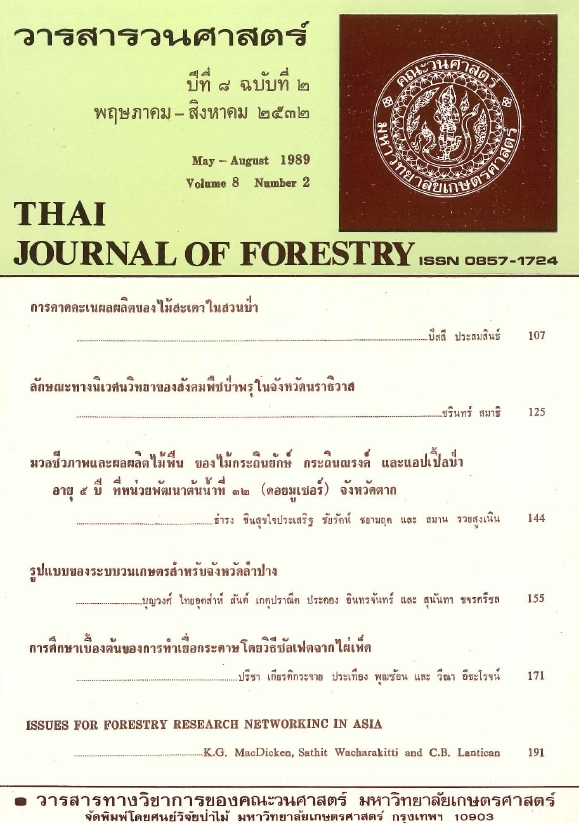ลักษณะทางนิเวศนวิทยาของสังคมพืชป่าพรุในจังหวัดนราธิวาส
Main Article Content
บทคัดย่อ
การศึกษาลักษณะทางนิเวศนวิทยาของสังคมพืชป่าพรุ โดยการศึกษาชนิดพืชและวิเคราะห์สังคมพืชเพื่อศึกษาความแปรปรวนของพรรณพืช และลักษณะโครงสร้างของสังคมพืชได้ดำเนินการในบริเวณป่าพรุที่ยังมีสภาพอุดมสมบูรณ์ ซึ่งมีเนื้อที่ประมาณ ๖๐,๕๒๕ ไร่ ตั้งแต่เดือนกุมภาพันธ์ ๒๕๓๐ ถึงเดือนกรกฎาคม ๒๕๓๐ ดำเนินการหาขนาดและจำนวนแปลงตัวอย่างที่ควรใช้ศึกษาป่านี้ ปรากฏว่าขนาดแปลงตัวอย่างที่เหมาะสมคือ ๔๐ x ๔๐ ตารางเมตร จำนวน ๒๑ แปลง วางแปลงตัวอย่างตามขนาดและจํานวนที่คำนวณได้บันทึกชนิดพืช จำนวนต้นพืชและวัดขนาดเส้นผ่าศูนย์กลางของลำต้นพืชทุกชนิดที่ปรากฏในแปลงตัวอย่าง ซึ่งปรากฏว่าพบพืชทั้งหมด ๑๔๓ ชนิด ประกอบด้วยไม้ยืนต้น ๗๙ ชนิด ไม้พุ่ม ๖ ชนิด พืชล้มลุก ๘ ชนิด เถาวัลย์ ๓๓ ชนิด ปาล์ม ๑๐ ชนิด เฟิร์น ๗ ชนิด และพืชอาศัย ๑ ชนิด ชนิดพืชที่มีค่าความถี่สัมพัทธ์ ความหนาแน่นสัมพัทธ์ ความเด่นสัมพัทธ์ และดัชนีความสำคัญสูงกว่าพืชทุกชนิด คือ กะเปรียะ ซึ่งเป็นพืชล้มลุกที่ขึ้นอยู่บริเวณพื้นป่า ชนิดพืชที่มีค่าดัชนีความสำคัญน้อยลงไป ได้แก่ ย่านลำเท็ง คมบาง และกะพ้อแดง ส่วนไม้ยืนต้นที่มีค่าดัชนีความสำคัญสูงกว่าต้นไม้ทุกชนิด คือ ฝาดแดง ชนิดไม้ที่มีค่าดัชนีความสำคัญน้อยลงไป ได้แก่ มะฮัง สะเดียว ฝาดขาว และหว้าหิน ต้นไม้และพืชเหล่านี้มีอิทธิพลต่อสังคมพืชป่าพรุมาก และมีโอกาสที่จะสูญหายไปจากสังคมพืชได้ยาก สำหรับพืชที่มีค่าดัชนีความสำคัญน้อยมาก ได้แก่ ย่านตูบอสะลูแว สายหยุด ย่านมันจระเข้ หมากขุ่น ย่านทาด เจ็ดหมูนป่า และชะบาช้าง ต้นไม้ที่มีค่าดัชนีความสำคัญน้อย ได้แก่ ข้าวเม่าช้าง มะเดื่อ ปูเละ กะทังทู้ ลาโกะ พญาไม้ และบือละ ซึ่งต้นไม้และพืชเหล่านี้ มีความสำคัญทางนิเวศนวิทยาของป่าพรุน้อยมาก มีขึ้นอยู่จำนวนน้อย และมีโอกาสล้มตายสูญหายไปจากสังคมที่ได้ง่ายมาก
Downloads
Article Details

อนุญาตภายใต้เงื่อนไข Creative Commons Attribution-NonCommercial-NoDerivatives 4.0 International License.
ข้าพเจ้าและผู้เขียนร่วม (ถ้ามี) ขอรับรองว่า ต้นฉบับที่เสนอมานี้ยังไม่เคยได้รับการตีพิมพ์และไม่ได้อยู่ในระหว่างกระบวนการพิจารณาตีพิมพ์ลงในวารสารหรือสิ่งตีพิมพ์อื่นใด ข้าพเจ้าและผู้เขียนร่วม (ถ้ามี) ยอมรับหลักเกณฑ์และเงื่อนไขการพิจารณาต้นฉบับ ทั้งยินยอมให้กองบรรณาธิการมีสิทธิ์พิจารณาและตรวจแก้ต้นฉบับได้ตามที่เห็นสมควร พร้อมนี้ขอมอบลิขสิทธิ์ผลงานที่ได้รับการตีพิมพ์ให้แก่วารสารวนศาสตร์ คณะวนศาสตร์ มหาวิทยาลัยเกษตรศาสตร์ กรณีมีการฟ้องร้องเรื่องการละเมิดลิขสิทธิ์เกี่ยวกับภาพ กราฟ ข้อความส่วนใดส่วนหนึ่ง หรือ ข้อคิดเห็นที่ปรากฏในผลงาน ให้เป็นความรับผิดชอบของข้าพเจ้าและผู้เขียนร่วม (ถ้ามี) แต่เพียงฝ่ายเดียว และหากข้าพเจ้าและผู้เขียนร่วม (ถ้ามี) ประสงค์ถอนบทความในระหว่างกระบวนการพิจารณาของทางวารสาร ข้าพเจ้าและผู้เขียนร่วม (ถ้ามี) ยินดีรับผิดชอบค่าใช้จ่ายทั้งหมดที่เกิดขึ้นในกระบวนการพิจารณาบทความนั้น”


